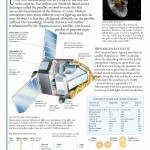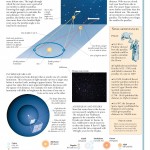Until 1838, Astronomers had little idea of the true size of the Universe. But in that year, Friedrich Bessel used a technique called the parallax method to make the first successful measurement of the distance to a star.
Modern astronomers have many different ways of figuring out how far away an object is, but they all depend ultimately on the parallax method.
As the Earth orbits the Sun, the nearer stars seem to move from side to side against the background of more distant stars. The angle through which the star moves over a period of six months is called its parallax.
Knowing this angle, astronomers can use simple geometry to calculate the star’s distance. The smaller the parallax, the further away the star.
Related posts:
Space messages tell about the biosphere, that includes the basic chemical compositions of the continents, oceans and atmosphere. The highest and lowest points of Earth and the surface strength of gravity are also listed in the space messages. Along with the relative sizes and ordering of the planets in our solar system, this message tells about the mass and radius of both our Sun and Jupiter. ...
The universe is expanding at an ever – increasing rate, with something that astronomers call dark energy appearing to push it apart faster than gravity can pull it together. Type la supernovas are stars that explodes with a predictable brightness. Light from distant supernovas locks dimmer and redder than expected, implying that the universe is expanding. The more distant the star, the fast...
The dominant features on the Moon’s nearside – the side that always faces the Earth – are the dark maria, which early astronomers thought were seas. These lava – filled basis formed when molten rock seeped through the Moon’s crust to fill depressions left by meteorite impacts.
Home galaxy of Earth, the Milky way is a spiral – shaped system of a few hundred billion stars. Bright regions of recently formed stars highlight its arms, while older stars explode or expel their outer layers as beautiful planetary nebulae, then fade away and die. A thick swarm of orange and red stars marks the galactic bulge, encapsulating the star-packed galactic center.
In this era of 50 years of Manned Space Flight, USA stands at the top of the list in the Nations with the most Astronauts who have been sent to the space. Russia stands at the third position with France and Germany following it. The farthest Manned Missions from Earth is Apollo 13 which has travelled around 401,056 km in 1970. Next farthest is Apollo 8 followed by Gemini 11 and Gemini 10. Yur...
Space architecture, in it is least complex definition, is the hypothesis and hone of composing and manufacturing possessed territories in space. The engineering way to space apparatus outline locations the aggregate raised earth, drawing...
Stellar advancement is the methodology by which a star experiences an arrangement of radical updates around its lifetime. Hinging on the mass of the star, this lifetime extends from just a few million years for the most gigantic to trillions of years for the slightest huge, which is impressively longer than the time period characterized by the universe. All stars are born from falling mists of...
Most astronomers believe that all the members of the solar system, from the giant Sun to the smallest asteroid, were born out of a vast, spinning cloud of gas and dust – the solar nebula. The process began 5 billion years ago with the formation of the Sun. The planets and other objects formed from unused material. When the solar system was nearly complete, 500 million years later, just 0....
Astronomers expect spectacular displays of meteor showers over North America and Europe on Wednesday and Thursday as the Earth crosses the path of Comet Swift-Tuttle’s Orbit. The comet you see from your eye is actually the icy dust from the comet burning off as it nears our Sun.
The process of existence or initiative of life in the Solar System looks very interesting. Life in the solar system is a monomeric nucleotide, pretty much just a simple molecular compound made out of a normal, every-day inorganic material. Life started in the Earth once the things inside it are cooled down a bit. Basically life in the Earth is a replicator, the way it just happened or formed. Life...
The actual Sloppier things are a set of huge things listed from the People from France astronomer Charles Untidier in his "List diethylstilbestrol Nebulousness et diethylstilbestrol Amas d'Étoiles" ("Catalogue of Formulations and Super legend Clusters"), initially released within side 1771, with the final inclusion (according to Messier's observations) manufactured in 1966.
What was the time outside the circle of light is now space, so a man can easily walk donw into our past. If he walks out of the loop, he may see himself waiting to go in. Inside the light beam, time is warped into a loop.
Scratches is presently accommodate to five working shuttle: several in circle—the Scratches Odyssey, Scratches Express, and Scratches Surveillance Orbiter; and two on the surface—Scratches Investigation Wanderer Opening and the Scratches Science Research facility Interest. Old space apparatus on the surface incorporate MER-A Spirit, and a few different idle landers and meanderers, both on trac...
Finding out the length of an orbit is a very tedious task. Unless one have flown aboard the space shuttle or have seen it in person, it can be difficult to mentally visualize the size of the vehicle. Here, we measure the orbiter against a familiar object, a school bus. The weight of Orbiter would weight around 178000 pounds. The heaviest African Elephant weighs 13200 pounds. It would take appro...
Until the 1st successful flyby of Mars took place 1965 simply by simply Mariner Four, numerous speculated concerning the reputation associated with water drinking h2o around the globe's area. This is based on noticed periodic versions learn how to as well as dark sections, specially in the particular polar latitudes, which were ocean and also locations; extended, dim grooves had been construed...
After Pluto was discovered in 1930, it was regarded as the ninth major planet, although it was soon found to be very different from the others. It is smaller than Earth’s Moon and follows an elongated, titled orbit. In the 1990’s astronomers began to discover small bodies similar to Pluto beyond Neptune. Some, such as Eris, were larger then Pluto. In 2006, astronomers decided to define a ne...
NASA has decided that the MPCV, or Multi-purpose Crew Vehicle, will be America’s next crewed spacecraft following the retirement of the space shuttle. The MPCV program is a refocus of the Orion Crew Vehicle Program, which has been in development since 2005.
The Sun is our nearest star. It is a huge, luminous ball of gas like all the other stars. It consists mostly of hydrogen, and helium with tiny amounts of other elements. The Corona is the outer shell of the Sun’s atmosphere. It is extremely hot with temperatures reaching up to 2 million degrees. In the radiation zone, the energy is transported outwards by radiation. It covers about 70% of the Sun’...



 Upload your infographic here and contribute to our community.
Upload your infographic here and contribute to our community. 
Leave a Reply